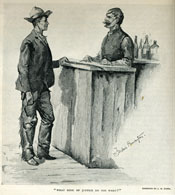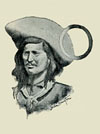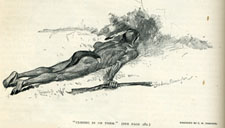
by
Theodore Roosevelt



“In
Cowboy Land,” by Theodore Roosevelt with pictures by Frederick Remington,
is a piece of literature published in The Century Magazine. President
Roosevelt starts out discussing how men hold the law in their own hands
out on the frontier. He says even many desperados and bandits have moral
sides and change depending on their surroundings. The frontier is open
and unsettled and this is tough on men because it is hard to establish
roots or a family. Therefore men of the west have a tolerance for misdeeds
of youth and do not cast away a fellow frontiersman for his past. Mr.
Roosevelt then goes on to tell stories and observations he has had while
living at his ranch near the Badlands in the Dakotas’.
The stories from “In Cowboy
Land” give great insight to the aspects of life on the frontier.
The first story tells a tale of justice and how the justice of the peace
can change quickly in a town and sometimes the gun is the law. The man
in the story is looking for a stolen horse and he finds the thief’s
house, but the man is not there. He decides to find the justice in town
only to find he has been shot by the constable. The probate judge is still
a live and in town but when he finds the man seeking justice is from out
of town, he loses interest and says he can shoot the man if he wishes.
The man ends up just taking his horse back and no more life is lost. In
the next one Mr. Roosevelt talks about how a friend got a scar on his
foot. This story shows the diversity of the characters in the West and
how to take care of people when they get out of hand. The third story
continues the theme of diversity by discussing the difference in people’s
backgrounds geographically and how a “kind of a Dutchman”
is different than a Dutchman. Then he writes about animals and the accidents
on the frontier. Roosevelt recounts many accidents involving death or
broken bones, even by experienced frontiersmen. People falling off horses
or encountering storms and losing the trail is commonplace on the frontier.
Mr. Roosevelt finishes with tales of encounters with Indians. The first
one describes a battle with Indians and how a few white men survived a
Sioux raid by limiting ammo and only shooting for definite kills. The
last one describes how important West Point officers were to the frontier.
Indians would often form battle groups and attack the whites. However,
many Americans on the East coast got upset when the Whites attacked Indians
and called it brutal killing. This put the officers into an attack only
if attacked first position. In one story, a young brave fires on officers and
the officers attack back and kill a prominent warrior. This causes the
whole Indian Crow war party to disband and the Indians run away to a stream
and wash their war paint off immediately.
The stories and observations of Theodore
Roosevelt show relations between people, land and animals on the frontier.
Women are non-existent in these tales and the gun is law. Although the
stories contain many hardships, the admiration of Mr. Roosevelt for the
frontier life can be seen.